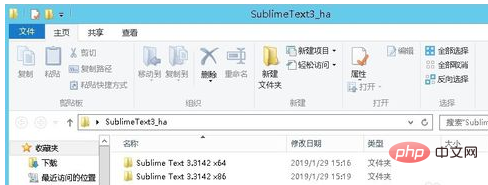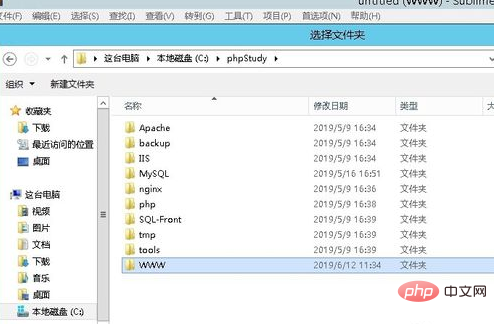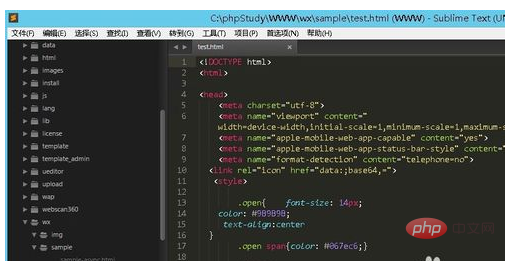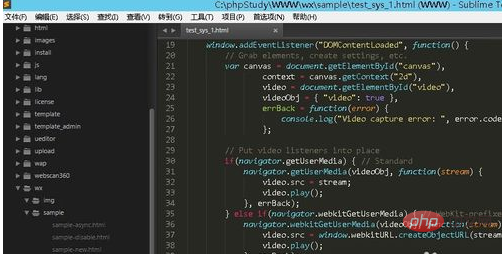How to modify the source code of php website

How to modify the source code of php website?
First download and decompress the SublimeText3 software.

Run the corresponding version according to your operating system.
Recommended: "PHP Tutorial"

In the file menu, select Open Folder to open the file where the source code is located Folder

Select the source code file you want to edit

Edit the code and save it.

The above is the detailed content of How to modify the source code of php website. For more information, please follow other related articles on the PHP Chinese website!

Hot AI Tools

Undress AI Tool
Undress images for free

Undresser.AI Undress
AI-powered app for creating realistic nude photos

AI Clothes Remover
Online AI tool for removing clothes from photos.

Clothoff.io
AI clothes remover

Video Face Swap
Swap faces in any video effortlessly with our completely free AI face swap tool!

Hot Article

Hot Tools

Notepad++7.3.1
Easy-to-use and free code editor

SublimeText3 Chinese version
Chinese version, very easy to use

Zend Studio 13.0.1
Powerful PHP integrated development environment

Dreamweaver CS6
Visual web development tools

SublimeText3 Mac version
God-level code editing software (SublimeText3)

Hot Topics
 1794
1794
 16
16
 1740
1740
 56
56
 1591
1591
 29
29
 1474
1474
 72
72
 267
267
 587
587
 Optimizing website SEO: practice of pseudo-static hiding php suffix
Mar 07, 2024 pm 12:27 PM
Optimizing website SEO: practice of pseudo-static hiding php suffix
Mar 07, 2024 pm 12:27 PM
As we all know, optimizing the SEO of a website is a very important part of website operation. The default URLs of dynamic web systems (such as PHP) used by many websites have extensions (.php, .html, etc.), which will affect the SEO effect of the website. In order to improve the optimization effect of the website, a common practice is to change the dynamic URL to a pseudo-static URL to hide the extension name and improve the user experience and search engine ranking of the website. This article will take "pseudo-static hidden php suffix" as the theme, introduce how to achieve this optimization in PHP websites, and
 What is the development method of Empire CMS template?
Apr 17, 2024 am 12:09 AM
What is the development method of Empire CMS template?
Apr 17, 2024 am 12:09 AM
Empire cms template development methods include: 1. Understand the template structure; 2. Modify the template code; 3. Use tags and variables; 4. Create custom functions; 5. Use CSS and JS; 6. Use template modules; 7. Debugging and test.
 Which websites are developed using php
Aug 11, 2023 am 11:03 AM
Which websites are developed using php
Aug 11, 2023 am 11:03 AM
Websites developed with PHP include: 1. Facebook, one of the world's largest social media platforms; 2. Wikipedia, the world's leading online encyclopedia; 3. WordPress, a widely used open source blog and content management system; 4. Twitter, a popular social media platform; 5. Yahoo, a world-renowned portal; 6. Flickr, an online image hosting and sharing platform; 7. LinkedIn, a professional social media platform.
 Which websites are made with php
Aug 11, 2023 am 10:55 AM
Which websites are made with php
Aug 11, 2023 am 10:55 AM
Websites made with PHP include: 1. Facebook, one of the world's largest social media platforms; 2. Wikipedia, an online encyclopedia edited by users around the world; 3. WordPress, a popular open source blog and content management system; 4. Slack, a widely used team collaboration tool; 5. Magento, a powerful open source e-commerce platform; 6. Etsy, an online marketplace for handicrafts and independent designers.
 Build a simple website in php
Mar 22, 2024 pm 03:04 PM
Build a simple website in php
Mar 22, 2024 pm 03:04 PM
Building a PHP website involves the following steps: 1. Prepare the environment, install the PHP development environment and create the website root directory. 2. Create the basic file structure, including the homepage index.php and other required files. 3. Write home page content, use HTML and PHP to build page structure and dynamically generate content. 4. Add other pages and create other PHP files to process page content. 5. Connect to the database (optional), use PHP to connect to the database and operate the data. 6. Design styles and interactive effects, and use CSS and JavaScript to enhance the beauty and interactivity of the website. 7. Deploy the website and upload the website files to the server or
 How to protect your PHP website using secure coding practices?
Aug 20, 2023 pm 06:05 PM
How to protect your PHP website using secure coding practices?
Aug 20, 2023 pm 06:05 PM
How to protect your PHP website using secure coding practices? With the popularity and development of the Internet, more and more websites use PHP as the development language. However, PHP's flexibility and ease of use also make it vulnerable to various security threats. Therefore, when developing a PHP website, it is essential to apply secure coding practices to protect the website from possible attacks. This article will introduce some ways to protect your PHP website using secure coding practices and provide corresponding code examples. Input Validation and Filtering Input Validation and Filtering is the key to protecting PHP websites
 What are the security policies of php on centos
Apr 14, 2025 pm 02:33 PM
What are the security policies of php on centos
Apr 14, 2025 pm 02:33 PM
Detailed explanation of CentOS server PHP security policy: Building a solid protection system This article will explore in-depth how to build a secure PHP operating environment on the CentOS system, covering multiple aspects such as system level, PHP configuration, permission management, HTTPS encryption and security monitoring, etc., to help you effectively reduce the risk of server attacks. Server security is a continuous improvement process that requires regular review and updates to security policies. 1. System security cornerstone system update: Keep the latest version of the CentOS system and all software packages, install security patches in a timely manner, and plug known vulnerabilities. Firewall protection: Use Firewalld to finely control server network access, and only necessary ports (such as HTTP port 80 and H
 How to use encryption algorithm to protect user data of PHP website?
Aug 19, 2023 pm 04:00 PM
How to use encryption algorithm to protect user data of PHP website?
Aug 19, 2023 pm 04:00 PM
How to use encryption algorithm to protect user data of PHP website? With the rapid development of the Internet, user data protection of websites has become more and more important. In PHP development, we can use encryption algorithms to protect the security of user data. This article will introduce some commonly used encryption algorithms and how to use them in PHP websites to encrypt user data. 1. Selection of encryption algorithms For PHP websites, we can choose the following commonly used encryption algorithms to protect the security of user data: 1. Symmetric encryption algorithm: This algorithm uses the same encryption algorithm.





